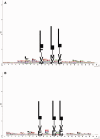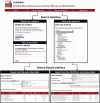ValidNESs: a database of validated leucine-rich nuclear export signals
- PMID: 23093589
- PMCID: PMC3531083
- DOI: 10.1093/nar/gks936
ValidNESs: a database of validated leucine-rich nuclear export signals
Abstract
ValidNESs (http://validness.ym.edu.tw/) is a new database for experimentally validated leucine-rich nuclear export signal (NES)-containing proteins. The therapeutic potential of the chromosomal region maintenance 1 (CRM1)-mediated nuclear export pathway and disease relevance of its cargo proteins has gained recognition in recent years. Unfortunately, only about one-third of known CRM1 cargo proteins are accessible in a single database since the last compilation in 2003. CRM1 cargo proteins are often recognized by a classical NES (leucine-rich NES), but this signal is notoriously difficult to predict from sequence alone. Fortunately, a recently developed prediction method, NESsential, is able to identify good candidates in some cases, enabling valuable hints to be gained by in silico prediction, but until now it has not been available through a web interface. We present ValidNESs, an integrated, up-to-date database holding 221 NES-containing proteins, combined with a web interface to prediction by NESsential.
Figures



Similar articles
-
NESdb: a database of NES-containing CRM1 cargoes.Mol Biol Cell. 2012 Sep;23(18):3673-6. doi: 10.1091/mbc.E12-01-0045. Epub 2012 Jul 25. Mol Biol Cell. 2012. PMID: 22833564 Free PMC article.
-
Prediction of leucine-rich nuclear export signal containing proteins with NESsential.Nucleic Acids Res. 2011 Sep 1;39(16):e111. doi: 10.1093/nar/gkr493. Epub 2011 Jun 24. Nucleic Acids Res. 2011. PMID: 21705415 Free PMC article.
-
NESmapper: accurate prediction of leucine-rich nuclear export signals using activity-based profiles.PLoS Comput Biol. 2014 Sep 18;10(9):e1003841. doi: 10.1371/journal.pcbi.1003841. eCollection 2014 Sep. PLoS Comput Biol. 2014. PMID: 25233087 Free PMC article.
-
Mechanistic insights from the recent structures of the CRM1 nuclear export complex and its disassembly intermediate.Biophysics (Nagoya-shi). 2012 Nov 30;8:145-50. doi: 10.2142/biophysics.8.145. eCollection 2012. Biophysics (Nagoya-shi). 2012. PMID: 27493531 Free PMC article. Review.
-
Controlling protein transport by small molecules.Curr Drug Targets. 2011 Oct;12(11):1574-80. doi: 10.2174/138945011798109446. Curr Drug Targets. 2011. PMID: 21561424 Review.
Cited by
-
A nuclear cAMP microdomain suppresses tumor growth by Hippo pathway inactivation.Cell Rep. 2022 Sep 27;40(13):111412. doi: 10.1016/j.celrep.2022.111412. Cell Rep. 2022. PMID: 36170819 Free PMC article.
-
pCRM1exportome: database of predicted CRM1-dependent Nuclear Export Signal (NES) motifs in cancer-related genes.Bioinformatics. 2020 Feb 1;36(3):961-963. doi: 10.1093/bioinformatics/btz657. Bioinformatics. 2020. PMID: 31504173 Free PMC article.
-
Nuclear export signal (NES) of transposases affects the transposition activity of mariner-like elements Ppmar1 and Ppmar2 of moso bamboo.Mob DNA. 2019 Aug 19;10:35. doi: 10.1186/s13100-019-0179-y. eCollection 2019. Mob DNA. 2019. PMID: 31452694 Free PMC article.
-
Components and regulation of nuclear transport processes.FEBS J. 2015 Feb;282(3):445-62. doi: 10.1111/febs.13163. Epub 2014 Dec 22. FEBS J. 2015. PMID: 25429850 Free PMC article. Review.
-
Deep learning prioritizes cancer mutations that alter protein nucleocytoplasmic shuttling to drive tumorigenesis.Nat Commun. 2025 Mar 14;16(1):2511. doi: 10.1038/s41467-025-57858-8. Nat Commun. 2025. PMID: 40087285 Free PMC article.
References
-
- Kosugi S, Hasebe M, Tomita M, Yanagawa H. Nuclear export signal consensus sequences defined using a localization-based yeast selection system. Traffic. 2008;9:2053–2062. - PubMed
-
- Turner JG, Sullivan DM. CRM1-mediated nuclear export of proteins and drug resistance in cancer. Curr. Med. Chem. 2008;15:2648–2655. - PubMed
Publication types
MeSH terms
Substances
LinkOut - more resources
Full Text Sources
Other Literature Sources

